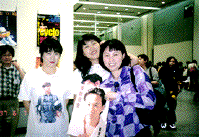 Science & Technology || Search || Back Numbers ACCEPTING ASIAN CULTURES:
 Young Japanese are turning their adoring eyes to Asia. (Photo: Hong Kong Film Promotion Society of Japan) Young Japanese are increasingly looking to the nearby countries of Asia for cultural influences. What is known in Japan as the "Asia boom" was ignited in recent years by a combination of films, music, travel and other factors, but appreciation of regional cultures has taken on broader and deeper dimensions. Attracting interest are not only East Asian cultures such as those of Hong Kong and Taiwan, but also those of Southeast Asia and the subcontinent. Underlying factors are the greater availability of information on the region and personal familiarity of young people with it through travel, cuisine and other cultural gateways. Cultures apparently are beginning to travel as freely as people.
Music, Magazines, and Movies Two years ago, another downtown store peddling Hong Kong films and related merchandise found its 16 square meters or so of floor space wasn't enough and took over another story in its building. Freshly made videos of films featuring such stars usually sell from 10,000 yen (83 dollars at 120 yen to the dollar) each, but the store can clear a batch of 50 instantly; sales have increased fivefold over the last two years. At a major record store in Shibuya, from which young people take their cues regarding what's hot in music, non-Japanese Asian artists now account for at least 40% of all sales of world music excluding reggae. The boom has also sparked the appearance of a string of special-interest magazines. One two-year-old publication, which is released mainly at record stores and runs interviews with glossy photos of Asian stars, manages sales of around 40,000 copies per issue. And a Japanese travel agency, which scored a hit with female office workers and others last year by incorporating a concert visit into one overseas tour, plans to repeat similar offers on a regular basis from this year. At the same time, Asian stars have been attracting the devoted retinues of fans for which Japanese "idols" are famous. Corporate advertising is also starting to make wider use of Asian stars. Many cosmetics companies field Caucasian women in their advertising. But the sector leader this spring broke with this and its own tradition by deploying a trio of actresses including two from Hong Kong in a spring campaign for a new brand. A spokesman said the move was timely, in view of the buoyant economic and cultural progress being enjoyed by Asians. Watching Southeast and South Asia One shop in Tokyo's Ikebukuro shopping area specializing in rental videos of South Asian films and sales of CDs has seen Japanese buyers, mainly young women, come to comprise around 20% of its customers. Said one female student who came to buy a CD: "There are exciting things in Indian music and films that you do not find in Japanese equivalents. I got to like this stuff last autumn while traveling." One apparent trigger for this broadening of interest in Asian culture was the exploits, aired in a popular spot in a variety show, of a pair of TV personalities who last year hitchhiked across the region on a shoestring budget. Partly as a result, there was such a boom in travel to India and Indochina that vendors of cheap travel tickets set up special counters. Travel agencies across the board reported that sales of cheap air tickets to Asia were set to surpass those to North America and Europe. By a similar token, the travel essays of Mitsuharu Kaneko (1895-1975), poet, writer, and global wanderer, are enjoying something of a revival as young visitors to Asia adopt them as their road bible. His accounts of traveling more or less pennilessly in China, Bali, and Southeast Asia and beyond have again struck a chord with young travelers after 70 years and helped fuel the boom in Asian travel. His writings have played an important role, too, in promoting Asian cultures, as many young Japanese bring back from regional travels an abiding interest in food, fashion, music, and other facets of Asian life. Spotlight on Hong Kong Of late, Hong Kong has been of special interest. With the recent preoccupation with its reversion to Chinese rule, opportunities for learning more about the place through television, magazines, and other media have increased manifoldly. But the entire Asian region has become more accessible, as increased reporting on social and economic matters is accompanied by coverage of its cuisines, fashion, music, and other cultural heritage. The fact that this information has not been processed to suit Japanese tastes, but is now coming in real-time in all its original liveliness, has apparently further stimulated the interest of young people, who as children of the postwar generation do not have such a prejudiced and alienated view of the rest of Asia. Therein lies a key feature of this "Asia boom": The young are less likely to pigeonhole. Rather than classifying films, say, as "French" or "Asian," they take them as they are and react according to personal inclination.  Edited by Japan Echo Inc. based on domestic Japanese news sources. Articles
presented here are offered for reference purposes and do not necessarily
represent the policy or views of the Japanese Government.
Edited by Japan Echo Inc. based on domestic Japanese news sources. Articles
presented here are offered for reference purposes and do not necessarily
represent the policy or views of the Japanese Government.
|
